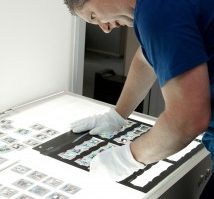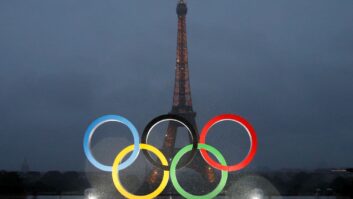
The International Olympic Committee (IOC) has been pushing the boundaries of TV and media production ever since the Stockholm games in 1912, yet no-one in the organisation was prepared for the catastrophic state in which its audio visual archive was found in 2006.
The IOC has a proud history of innovations ranging from the Technicolor film of London 1948, to the first HD test in 1984 in LA and early video to mobile tests from the 2006 Winter Games in Turin. However, an internal audit in 2006 revealed the alarming extent of the archive’s deterioration. It found that within a decade, half of the IOC’s 33,000 hours of video would be unplayable, 20 per cent of its 400,000 stills would have faded beyond use and there would no longer be a player to listen to much of the 8,500 audio recordings.
The collection spans official films, technical films, behind the scenes footage, unedited broadcast rushes and newsreel collections. The IOC has opened a new exhibition at the Olympic Museum on the banks of Lake Geneva in Lausanne to highlight the results of an SFR 30 million digitisation and logging effort.
Official film restoration
Back in 2006 the 40 official olympic films were in dire need of restoration with large pieces missing and uncatalogued. “I was informed that a century of Olympic images was in danger of disappearing irreversibly,” explained IOC president Jacques Rogge who greenlit the digitisation programme in 2007. “In the digital age it is vital to have a digital version of this patrimony especially if we want to promote the Olympic brand around the world.”
Less a highlights reel and more an evocation of the spirit of each Games and an artistic representation of the period, the official films have attracted A-list directors including Claude LeLouche, Milos Forman, Arthur Penn, John Schlesinger and Mia Zetterling.
“In 1912 the reels would have been shot, processed, edited, packaged and sent to play in theatres within a single day,” explained Adrian Wood, IOC consultant, acquisition and restoration. The original 16mm negative reels of the 1912 games have been scanned to 4K and now provide a remarkably detailed record.
Leni Riefenstahl’s controversial work Olympia documenting the 1936 Berlin Games is among the restored pieces. “She was deeply unpopular because she made propaganda for Hitler but also there was jealousy because her films are among the most impressive of their type and being made by a women made her a tabloid hate figure,” explained Kevin Brownlow, film historian, documentary-maker and film editor who met her in the 1980s to restore the footage.
Producer/director Caroline Rowland had to fight to document London 2012 with an official film. “London did not include provision for a film in its charter,” she explained. “LOCOG weren’t sure if it was a relevant addition to the legacy of the Games. Given that there is so much multi-screen coverage of the Games today that is a legitimate question to ask.”
The solution that convinced the committee to fund the project was to track the achievements of first time Olympians to chime with 2012’s theme of inspiring a generation. Until recently the IOC has not involved itself in the production of these films so it had no ownership over the original elements, much of which is spread worldwide in private collections. The entire 1960 official film is still missing.
“We are not like a major studio which has all negatives in house and can access the vaults,” said Wood. “A lot of research went into finding where those original elements might be. Different cuts have been made for different audiences which begs the question of what version to restore when we find the films. And most of the time we’ve no access to production records which explains why changes were made, how many versions and what the post production methodology was. We are missing all of these because we are not the producers of the films.”
However, restoration, digitisation and comprehensive metadata logging of the archive is now complete. For long term archive the official films are preserved on new 35mm polyester-based film stock with digital files backed up to LTO tape. They are versioned in 2K and 4K DCP for theatrical presentation with HD access copies for broadcast.
“We haven’t faced the 4K TV yet,” said Wood. “We’ll leave that problem for the next generation.”
With the 2020 Games being broadcast in 8K domestically in Tokyo the organisation is aware of challenges ahead. “What is certain is that we need more agility in archiving technology to cope with the changes in format,” said Blaise Chardonnens, IOC head of images services.
Olympic coverage challenges
All of this work is important not just as a legacy but to form the backbone to a new Olympic channel set to launch worldwide ahead of Rio 2016. It is one of a number of media strategies the movement is spearheading in order to reach younger audiences and maintain its brand awareness in an age of digital distraction and discovery.
Other initiatives include a new approach to how the IOC presents and broadcasts the Games. The delivery of more content to multi-screens has highlighted a tension between traditional broadcaster directed or curated coverage and the potential – and seemingly pent up demand for – individuals to compile and view their own playlist on-demand of any and all aspects of Olympic coverage.
“The ideology of all sports broadcasting has changed from filming from the perspective of a viewer in the stand to filming from an athlete’s POV and to be as close as technically possible to the action,” explained Yiannis Exarchos, CEO, Olympic Broadcast Services (OBS) citing the use of tracking cameras for 100m or underwater cams tracking swimmers.
“What has also changed is filming only once the athletes are in the stadia to filming behind the scenes of key preparation moments such as the motivation of coaches, visualisation in alpine skiing or the mental and physical preparation of athletes,” he said.
“There is now pressure to introduce more wearable cameras into the field of play. While today’s elite athletes are getting used to this media jungle we have to be sensitive to introducing technology that doesn’t interfere with the integrity of the performance. Involvement of media in sports competition is aggressive. We want to get cameras closer to the athlete and even on the athlete, but we have to respect the athlete.”
At Rio 2016 coverage will include wearable cameras on equipment (track cycles, yachts) and on referees (eg basketball). It is also looking to use mini-cams on athletes during training sessions in the run up to the games. Body-worn health science sensors – such as heart rate monitors – are also on the radar.
“Fundamentally what we are doing with broadcast coverage is storytelling that conforms to classic Greek drama that has existed for 4,000 years,” said Exarchos, a Greek national. “You need to define the characters and tell the story of those characters, bring their story to a resolution and experience a catharsis of emotion as a result of that arc. What keeps me awake at night is how we can integrate a more democratic storytelling into coverage of a sport event?”
Following the 2014 winter games in Sochi where more video was watched on digital platforms that on linear channels for the first time, the IOC has declared Rio will be the first real multi-screen games.
“Broadcasters traditionally have been very keen to control what is being produced and for people to follow next the story they want to tell,” explained Exarchos. “Today, everybody is a storyteller. Everybody has capacity to produce audio visual content. Integrating these elements into an overarching narrative is, I believe, the most important challenge for broadcast storytelling in years to come.”







